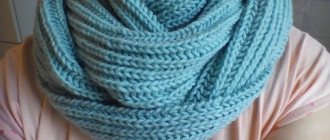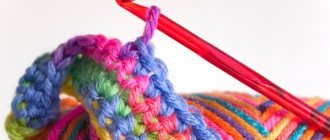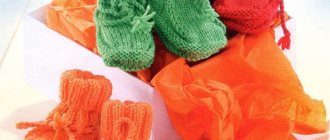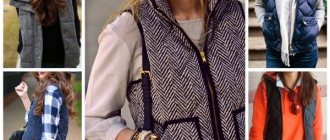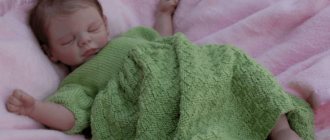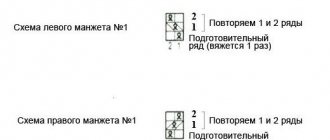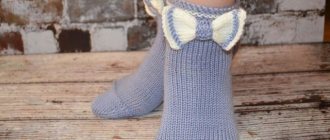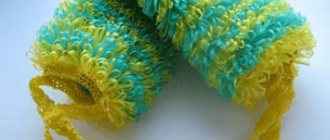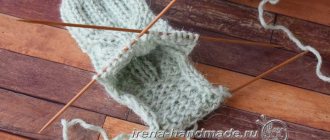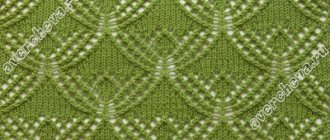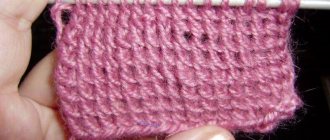we'll tell you how to make raglan on top
Knitting is a great way to spend time usefully, because this activity allows you to enjoy the process itself, as well as create exclusive things for yourself and your children. So, a sweater for a newborn is knitted quite quickly, and it will be very useful for the baby for cool days and walks in the fresh air.
General recommendations
When knitting clothes for newborn babies, it is best to choose special baby yarn, which usually consists of acrylic or cotton. Products made from it are soft, comfortable and hypoallergenic. You should not decorate things with metal objects or unnecessary accessories, which can prick the child’s delicate skin or cause inconvenience.
Simple knitted blouse for baby
This model is suitable even for beginner knitters, and the blouse turns out to be quite interesting and even stylish. Size – up to three months.
To knit it you will need:
- children's yarn (50g/100m) – 150g;
- knitting needles No. 3;
- 4 buttons.
For the product you will need to knit the elements corresponding to the diagram in the photo below.
Back
- Cast on 58 stitches, knit two centimeters in garter stitch, then move to stockinette stitch.
- After 11 cm from the beginning of knitting, in every second row we close the loops for the armholes on both sides: 1*3, 1*2, 1*1.
- After 13 cm from the beginning of the work, we again switch to garter stitch.
- After 21 cm from the bottom of the product in every second row we close the loops for the shoulder bevels - 3 * 5. At the same time we close off the middle 6 loops to form the neckline, in the next row there are another 5 loops on both sides. In the next row, bind off the remaining stitches.
Shelves
Let's start with the right one. We cast on 42 loops, knit two cm in garter stitch. Next we continue 4 stitches in garter stitch and the rest in stockinette stitch. After 2 rows from the beginning of the front stitch, we knit a bear according to the pattern using front and back loops.
- After 11 cm from the bottom of the product, form an armhole similar to the back.
- After 13 cm from the start of work, continue with garter stitch.
- After 14 cm, at a distance of three loops from the beginning of the row, form a hole for buttons by knitting two stitches together and throwing a loop, in a similar way, make a second hole through 16 stitches. from the edge. Repeat after another 3.5 cm.
- After 19 cm from the start of work, form a neckline: close 13 stitches, in every second row another 2*2, 1*4.
- On the other side, we simultaneously form a shoulder, closing 3*5p in even rows. At a total height of 22 cm, close all loops.
The left front is knitted in the same way as the right one; instead of the pattern, a stockinette stitch is made.
Sleeves
We cast on 36 loops. We knit two cm in garter stitch, continue with stockinette stitch, making increases on both sides:
- in every 6th row 4*1;
- 4 rows from the last sixth 1*1.
After 8.5 cm from the start of work, close on both sides in even rows: 1*3, 2*2, 6*1, 1*2, 1*3. At a total height of 13 cm, close all loops.
Assembly
Sew the parts together, sew on buttons. How to knit a raglan sweater for a baby
Clothes for newborn children should be especially comfortable - soft, delicate, breathable, preferably without seams. That is why one of the most popular knitting patterns for babies is a blouse with a raglan top.
To knit this pattern you will need the following materials:
- knitting needles with fishing line;
- circular knitting needles;
- regular knitting needles;
- hook;
- children's yarn – 150g;
- scissors;
- buttons.
The number of all knitting needles must be the same. Their diameter should be approximately the same as the thickness of the yarn.
You can choose two or more colors of thread and make the blouse striped; you can choose plain or melange yarn. There are no strict rules in this matter; it all depends on who the item is intended for (a boy or a girl) and on the personal preferences of the knitter.
The master class presents calculations for a baby up to two months.
Progress
- Knitting starts from the top, that is, from the neck. We cast on 40 loops on knitting needles with fishing line, knit 4-6 rows with an elastic band (one front loop, one purl).
- We distribute the loops on the shelves, sleeves and raglans, back: 5,8,12,8,5. Raglan are two loops before the sleeve and two loops after. In order not to get confused, the division points can be marked with special plastic markers for knitting.
- We continue to knit, making one loop increment in the front rows before and after the raglans. In this way, you need to knit until the resulting upper part of the product reaches the line of the child’s armpits (can be measured using any blouse or child).
- We transfer the sleeve loops to an auxiliary thread. We knit the remaining part with one straight piece to the end, finish the product with an elastic band, and close all the loops.
- We distribute the sleeve loops on circular knitting needles. We knit in the round and also finish the edge of the product with an elastic band.
- Using straight knitting needles, we cast on loops along the edge of the bar (there should be as many as there are rows in the product), knit several rows, leaving holes for buttons on one side.
- Sew on the buttons, the product is ready.
A selection of videos on knitting sweaters for newborns
We offer you to watch several videos with instructions on knitting blouses for babies.
sdelala-sama.ru
Choosing a model
Before you start knitting, you need to resolve several important issues. The first is what the finished product will be like: warm or openwork. The choice of thread will depend on this.
Important! Threads for products for a newborn should be soft, since the baby’s skin is very sensitive.
The material from which the threads are made must meet certain requirements. It should be hypoallergenic and best made from natural fibers. For children's clothing , threads made from cotton or acrylic are best suited . Acrylic has all these qualities, although many people think that it is not entirely suitable for children's things.
Next, you should select a model. Below you will see a knitted jumper for a newborn for beginners, made in the raglan style.
Raglan is a knitting method in which the whole product is knitted together with the sleeves, starting from top to bottom.
It comes in pink, making it more suitable for girls. But if you change the color, then the boys will be very comfortable in it.
Related article: Large Kinder Surprise made of paper with your own hands according to the master class
So, the model has been selected. All that remains is to prepare the rest of the materials, and you can get started.
Number of threads: 200 g of yarn of any color and 50 g of white yarn. Materials that will still be required: knitting needles No. 3 or 4, scissors, a needle, sewing thread and buttons that match the color of the blouse.
The age of the child for which the model is presented is up to three months (for the average child).
If the child for whom the blouse will be knitted has not yet been born, then it is necessary to calculate the required number of loops for knitting. To do this, it is necessary to take as an example the approximate dimensions of an average newborn. That is, its neck circumference will be approximately 22 cm. And the knitting density will be somewhere around 2.5 loops per 1 cm. Thus, having made the necessary calculations, it turns out that the neck of the blouse will be approximately 20 cm, which is 40 loops.
If the baby has already been born, then you can simply make a pattern. A knitted blouse pattern for a newborn baby will greatly simplify the knitting process. And in this case it will be more difficult to make a mistake with the size.
Knitted jumper for newborns with raglan sleeves
It is generally accepted that the best clothes for newborn babies are rompers and baby onesies.
But young mothers categorically disagree with this, because they want to dress up the baby from his first days. Children who were born in the warm autumn, spring or early summer can flaunt in knitted blouses, overalls and sets. Clothing for newborns must meet several requirements: it must be comfortable, without unnecessary strings and fasteners, it must be easy to take off and put on (sweaters with a tight neck are not suitable for such purposes) and be of high quality, not itchy, not biting, not cause irritation and be pleasant to the baby’s body.
Alize classic LanaGold yarn is suitable for knitting clothing sets for newborns. The thread meter is 240 meters per 100 gram rebel. In order to knit a blouse for a child 50-52 cm tall, you will need one skein of this yarn.
We start knitting from the back. We cast on 50 loops on the knitting needles and knit 3 cm with a 1x1 elastic band, alternating knit and purl loops.
For the sweater I chose the “Tooth” pattern. It is voluminous, the product will be soft, airy and warm. For repeat, you need a number of loops that is a multiple of 4 and another 5 loops, 2 of which are edge loops.
We calculate the loops: 50/4 = 12.5 repeats (rounded to 13).
We recalculate: 13 * 4 = 52 + 5 loops = 57 loops
In the last row of elastic, we evenly add the missing loops.
Note: If you decide to round the number of repeats downwards, then when recalculating you will get 12 * 4= 48 + 5= 53 loops.
The clove pattern is easy to knit, but the yarn consumption increases.
Pattern Description:
1st row: 1 edge, * 3 purl, 3 faces. pulled from one (description below) *, repeat from (*) as many times as required repeats along the width of the canvas, 1 edge.
2nd row: 1 edge, * 2 knits, 2 purl, 2 purl. knitted together * repeat from (*), 1 chrome.
3rd row: 1 edge, 1 purl. * 2 knits together behind the front wall, 1 knit, 2 knits together behind the back wall) *, repeat from (*), 1 chrome.
4th row: knit according to the pattern. Repeat from the first row.
Description of 3 knit stitches pulled from one loop: pull 1 loop from the knit stitch, without removing it from the knitting needle, make a yarn over, and pull the second knit stitch from this knit stitch, then remove the loop from the knitting needle.
Having knitted about 10 centimeters, we begin to decrease the loops for the raglan armhole. To do this, in each new row you should decrease 1 loop (i.e. knit them together) on both sides. After knitting another 10 centimeters, close both shoulders separately, having previously formed the neckline.
For the shelf we cast on 25 loops (for the pattern) + 10 loops (for the bar). Having knitted 3 cm with an elastic band, add 4 loops to the area where the pattern will be and, distributing the loops, knit similarly to the back, not forgetting about the bar.
Calculation of loops for a shelf. We only increase by 25 stitches of the pattern
25/4=8 rapports
8 * 4 = 24 + 4 (1 edge goes into the bar) = 28 loops
28 loops for the pattern + 10 loops for the strap = 38 loops in total on the shelf.
We knit the second shelf symmetrically to the first, not forgetting to make loops for buttons
For the sleeve, we cast on 40 loops and knit similarly to the back, but by decreasing the loops for the armhole we reduce the sleeve to zero.
Now we first sew the front and back, and then sew in the sleeves.
For the collar, cast on 80 stitches, knit it with a 1x1 rib and then sew it to the neckline.
We mark the places where the buttons should be and sew them on.
The blouse is ready.
Author – Madame Tsygul, for the site “Khomyak55”
www.homyak55.ru
Knitting a blouse for a newborn
In this article:
When you have a baby, you especially want to surround him with love and tenderness. A beautiful and soft knitted blouse will decorate your little one's wardrobe. These little things are very easy to knit, but they turn out beautiful and versatile.
Knitting a blouse for a newborn with knitting needles will help you choose a model to suit every taste. When looking for a style, remember that a simple model without rough seams is best suited for a small child. For example, a raglan blouse with buttons or an openwork blouse-sweater.
We knit a raglan blouse with buttons
When choosing yarn, pay attention to its composition. For small children, natural yarn without artificial additives in delicate pastel colors is best suited. Things made from acrylic are lighter; made of wool, mohair, angora are useful for walking outside.
For knitting you will need:
- yarn: 2 skeins;
- knitting needles: No. 3 - for sleeves; No. 2 - for elastic; on line No. 3 - main ones; long No. 2 - for sides;
- hook for tying;
- buttons 4-5 pieces.
Step-by-step instruction:
- We cast on loops according to the volume of the child’s neck (for example, 50).
- We knit an elastic band 1.5 cm wide.
- Next, we move on to the main knitting needles and distribute the loops for the raglan: 6 - shelf; 3 - raglan; 6 — sleeve; 3 - raglan; 14 - back; 3 - raglan; 6 — sleeve; 3 - raglan; 6 - shelf = 50.
- We knit the top waistband of the blouse about 10 cm in front and back rows. In the front row, we make yarn overs before and after each raglan. Purl rows are worked as usual.
- We lower all the loops of the sleeves onto the auxiliary threads, focusing on the resulting diagonal of the raglan.
- And we knit both shelves and the back with fabric to the desired length, then 1.5 cm with an elastic band and close the edge.
- We knit the sleeves one at a time using circular knitting needles No. 3, finish with an elastic band, and close the edges.
- We tie the length
moirody.ru
Blouse for newborns with openwork raglan lines and hem
A blouse-jacket for the little ones is knitted with knitting needles, decorated with openwork patterns along the bottom of the product, reminiscent of flowers, and a pattern of leaves along the raglan lines. The model is suitable for both girls and boys, depending on the chosen color of yarn and buttons.
Size: 3 months, fullness 50.
You will need: 110 g of merino yarn (the model uses Dream in Color Smooshy yarn 411.5 m in 110 g) circular knitting needles No. 3.5 buttonhole markers (4)
Density: 6 pet. and 9 rub. = 2.5 cm.
1 pull to the left: slip 1 loop as when knitting, knit, pull through the removed loop. 3 together knit with a slant to the left: slip 1 loop as when knitting, knit 2 together, pull through the removed loop.
Pattern No. 1: Row 1: knit 3, knit 2 together, yo, knit 1, yo, 1 stretch to the left, *Knit 5, knit 2 together, yo, knit 1, yo, 1 stretch to the left; repeat from * * to last 3 stitches, knit 3. Row 2 and all even ones: purl Row 3: knit 2, knit 2 together, yo, knit 3, yo, 1 pass to the left, * knit 3, knit 2 together knits, yarn over, knit 3, yarn over, 1 stretch to the left; repeat from * * to last 2 sts, k2 rows 5 and 7: as Row 1.
Pattern No. 2: Row 1: (K1, yarn over) 2 times, knit 3 together with a slant to the left, knit 3, knit 3 together, (yarn over, knit 1) 2 times. Row 2 and all even ones: purl Row 3: knit 1, yarn over, knit 3, yarn over, 1 stretch to the left, knit 1, knit 2 together, yarn over, knit 3, yarn over, knit 1. (2 stitches added) Row 5: K1, yarn over, 1 pull to the left, k1, k2 together, yarn over, knit 3 together with a slant to the left, yarn over, 1 pull to the left, k1, k2 together ., yarn over, knit 1. (2 stitches decreased) Row 7: K1. (yarn over, 1 stretch to the left, knit 1, knit 2 together, yarn over, knit 1) 2 times Row 9: as Row 7 Row 10: purl Description.
Back and front. Cast on 131 stitches. Knit 11 rows. K5, purl. to the last 5 sts, k5, knit 5, knit with Pattern No. 1 to the last 5 sts, k5. Repeat these two rows until Pattern No. 1 is completed.
K5, purl. to last 5 stitches, k5, k33, place marker, k65, place marker, k33.
K5, purl. to the last 5 stitches, knit 5. (Knit to 3 stitches before the marker, knit 2 together with a slant to the left, knit 2, knit 2 together) 2 times, knit to the end. Knit another 7 rows in the same way.
Repeat the last 8 rows 2 more times, or knit in this way until the length of the fabric reaches 11.5 cm, ending with a purl row.
(119 pet.).
Transfer the stitches to temporary needles or thread, leaving the markers in place.
Sleeves (2 parts): Cast on 30 stitches. Knit 10 rows.
K1, add 1 p, knit. to the last sts, add 1 st, k1. Knit 3 rows in garter stitch. Repeat the last 4 rows 3 more times.
K1, add 1 p, knit. to the last sts, add 1 st, k1. Knit 5 rows. satin stitch.Repeat last 6 rows 3 more times (46 stitches)
Knit in this manner until the length of the sleeves reaches 12 cm, finishing with a purl row. Set aside knitting.
Yoke. Transfer the back and front loops back to the knitting needles. Knit up to 8 stitches. in front of the marker, k2 together. with a slant to the left, place a marker, knit 6, remove the marker, knit 7. from the stitches of the first sleeve, place a marker, k2 together, knit to the last 3 stitches. sleeves, 2 faces together. with a tilt to the left, place a marker, faces. to the end of the sleeve, knit 1. from back stitches, knit 2 together, knit up to 3 sts. in front of the marker, k2 together. with a slant to the left, place a marker, k1, k1. from the loops of the second sleeve, knit 2 together, knit to the last 9 stitches. sleeves, 2 faces together. with a tilt to the left, place a marker, faces. to the end of the sleeve, knit 6. from the loops of the left front, place a marker, k2 together, knit. to end.
Row with a button hole: k2, yarn over, k2 together, k1, purl. to last 5 stitches, k5.
Persons up to 2 pets. in front of the marker, k2 together. with a slant to the left, knit with Pattern No. 2 between markers, k2 together, (knit up to 3 sts before the marker, k2 together with a slant to the left, k2, k2 together) 2 times, knit. up to 2 pets. in front of the marker, k2 together. with a slant to the left, knit with Pattern No. 2 between markers, k2 together, knit. to the end. 5 knits., purl. to last 5 stitches, k5.
Repeat last 2 rows until 83 stitches remain on needles, doing a row with a button hole every 10 rows.
Knit row 1. Knit row 1, decreasing 6 stitches evenly. Repeat last 2 rows 4 more times (53 stitches).
Close all loops.
Translated from here.
Other incarnations.
moipetelki.ru
Subtleties of the process
Throughout the entire knitting process, mommy puts her soul into this thing. First you need to find out exactly how to knit a blouse for newborns. You also need to understand the diagrams in advance. Such a thing, if there is perseverance, diligence and a desire to do something wonderful, can be accomplished even by a person completely ignorant of these things. But still, beginners are not advised to take overly complex schemes. It takes a long time to figure them out, they are knitted quite unusually, so you have to work hard.
To knit a blouse for a newborn with knitting needles, for beginners you will need the Internet. In its vastness there is a huge number of both printed descriptions and various step-by-step video tutorials. You can find a completely variety of designs - from the simplest and most uncomplicated to complex, elaborate and very unusual things.
It is necessary to clearly determine at the beginning of the process which of the varieties of blouses for babies and infants is worth choosing. It should be selected based on the mother’s personal preferences and the time of year. The most popular variations are :
- Classic standard straight cut blouses. No frills. They will be very well received by both girls and boys. If you add an unusual pattern to them, then such a thing will look just great. It is worth adding some decorations to the basic item. These can be beaded flowers, cute knitted pompoms or small toys attached to the lapels of a sweater like brooches.
- Sweater. This model is also suitable for everyone. The so-called seamless type of knitting is especially popular these days. In this case, the child will not feel any discomfort when wearing the item. Many mothers know what a problem it is when their child simply flatly refuses to wear this or that item of clothing. The whole problem lies precisely in the feeling of discomfort experienced from clumsy joints and incorrectly made seams.
- Blouse with a hood. Not all children like clothes with a hood. But if the child has nothing against it, then you can try. There is also one special nuance. Knitting a blouse step by step is usually quite simple. But attaching the hood is not so simple. Therefore, it is worth thinking in advance about whether the craftswoman has time for additional trouble.
- Jacket. This element is also slightly less popular than the first two, but nevertheless, it is in use. Since jackets do not have sleeves, they are the best solution for warm but rather windy weather. And it will add additional charm to a child’s image.
- In recent seasons, the raglan jacket has become increasingly popular. For a newborn, it will be very comfortable and warm enough, but at the same time it will not hinder the movement of the little restless toddler.
Video lessons on knitting a blouse for newborns
The best gift for a young mother will be a warm and beautiful blouse for her baby. Here you can not limit yourself in your imagination, because children's clothing can be bright, cute and funny. The main condition is soft hypoallergenic yarn. As a rule, the label of yarn intended for children's knitting contains the word “Baby”. This thread does not prick, tolerates washing well, and has a wide palette of colors: from delicate pastels to very bright ones.
Knitting children's clothes does not imply the use of accessories such as zippers, Velcro, hooks and metal buttons, as they can scratch the baby's delicate skin. Give preference to smooth plastic or wooden buttons.
Jacket with raglan sleeves
Let's try to knit a blouse with raglan sleeves. This product is knitted without seams, which is very convenient and comfortable for a small child.
Work starts from the top at the neck. Measure the circumference of the baby's neck and cast on the required number of stitches. For a one-month-old baby you will need 35-40 loops. Knit two centimeters with a 2x2 or 1x1 elastic band.
Now let's start working on the main part. The product is knitted in one fabric, so you need to correctly distribute the stitches for the two shelves, sleeves and back. The back is two P more than the sum of the two shelves. For example, there are 12 loops on the back, 5 on the front and 5 on each sleeve. You can place markers or tie strings between sections. In each front row we make P additions on both sides of each marker.
We continue knitting, making additions. Now the raglan lines become visible and you can use them to determine how many centimeters you still need to knit.
We transfer the P sleeves to other knitting needles or auxiliary threads, and continue to knit the product.
We knit the blouse to the length you require and close the fabric.
Now we begin knitting the sleeves. We will knit them in the round; for this you can switch to double needles or knit on circular needles using the “magic loop” technique.
We finish with a 2x2 or 1x1 elastic band. Close P.
Identical to the first, you need to knit the second.
To make the blouse look finished, we will knit the strips. We put the front loops on a knitting needle and knit 3.5 cm with an elastic band, not forgetting to leave holes on one strip.
You will need to sew cute buttons onto the second bar. The knitted blouse for a newborn is ready!
Video: Raglan jacket for a newborn
Option for beginners
Let's start with the simplest model of a blouse, which is suitable even for beginner craftswomen.
Let's start by knitting the back. Instead of a pattern, you can use a ready-made baby blouse. First, knit a sample to calculate how many loops (abbreviated below as P) in one centimeter. To determine how many P's you need for a set, multiply the number of P's in the sample by the number of centimeters you need and divide by the number of cm in the sample. For example, the pattern is 10 cm in which there are 16 loops, and you should knit 25 cm, then 16x25/10 = 40 loops.
Having dialed the required number of P for the back, knit three to four centimeters with a 2x2 elastic band. Now go to the front stitch (odd rows are knitted with knit stitches, even rows are knitted with purl stitches). Continue knitting the rectangle to the desired height. Now close P. The back is ready!
Right shelf. Divide the number of Ps that you collected for the back in half - this is the size of the shelf. We also start knitting with an elastic band, then move on to the stockinette stitch. When there are four cm left to the top, we begin to form the neck. To do this, we begin to close the P on the left side, knitting two stitches together at the beginning of each front row and at the end of each back row, making a “rounding” of the neckline.
Left shelf. Knitted identically to the right one, the only difference is in the formation of the neckline. Make decreases in a mirror manner.
Sleeves. We start knitting with a 2x2 elastic band, then move on to the stockinette stitch. Having knitted three to four centimeters, begin to make increments of one P in each odd row. To do this, knit two from the edge P (one for the front wall, the other for the back). The canvas should approximately double in size. Having knitted the desired length, close the fabric. The second one is knitted identically. Fold each piece in half and sew with a needle or hook.
Product assembly. Make shoulder and side seams, sew in sleeves. Try not to make the seam rough and rub the baby's skin. The neckline can be decorated with a 2x2 elastic band.
Video: First experiences of raglan knitting for kids from Svetlana Kolomiets
A selection of photos of MK knitting for kids
vnitkah.ru
Tips for choosing threads and patterns
It is usually advised to buy acrylic threads or natural ones such as cotton or wool. We immediately advise you not to mess with acrylic for the smallest crumbs - the child does not yet have normal thermoregulation during this period, babies tend to sweat, and acrylic can sometimes feel stuffy for adults, too. So it’s better to look for natural threads - for winter you can find half-woolen or woolen ones marked “Baby”, this yarn is always soft, delicate, hypoallergenic.
Of course, natural thread is somewhat more expensive than synthetic materials, however, a small child will need very little of it, and we’ll tell you how to save below.
It’s great to use wool and silk - the thread is delicate and just flows. For the warm season, mercerized cotton is suitable.
How to decide on a model? Let’s say right away that when choosing a model and design, you should focus on two main points:
- comfort for the baby - the blouse must be knitted so that it does not interfere with other clothes, does not get confused and is safe (buttons must be firmly sewn and not located on the back, it will be uncomfortable for the child to lie down);
- convenience for the mother - like any other clothing for newborns, it is better to make the blouse with a fastener along the shoulder or at least along the front, this will make dressing the child much easier.
Another point is the choice of model. Here it is better to act according to the principle “the simpler the better.” So no complicated armhole lines. A rectangular back, shelves and a sewn-in straight sleeve are the best option.
However, raglan is recognized as the best - this is the method when knitting starts from the top. What's good about raglan? It is absolutely incomparable, as it allows you to knit a sweater so that the knitting ends at the bottom. This means that, if necessary, the edge of the product can be unraveled and tied with new threads. This is a very convenient technique, it just allows you to use an item knitted with expensive threads to its fullest.
There is another way to save material by knitting without side seams, making the back and both shelves with one fabric. In addition to the fact that it is easier to knit, it also allows you to avoid unnecessary breaks, which is important when unraveling the threads if the baby grows up and you want to knit some of these threads a second time. Knitting without seams is easier to do on circular knitting needles, this makes the task easier.
Knitting a blouse for a newborn using photos and videos MK
Homemade crafts such as knitting are considered one of the pleasant ways to spend free evenings and more. Knitting will help you take your mind off pressing problems, relax, and most importantly, diversify your adult and children's wardrobe with original and unique things. If you are a young mother on maternity leave who knows how to hold knitting needles in her hands, then we suggest you knit a blouse for a newborn instead of buying a factory-made analogue. For beginners, this option will be ideal.
Some nuances for knitting for newborns
To knit a sweater for a newborn correctly, you need to follow some nuances:
- It is best to use acrylic yarn or, of course, cotton yarn. When purchasing threads in a store, do not forget to specify that you need cotton yarn for knitting children's items. In this case, you should be offered gentle and hypoallergenic threads. First of all, they should be natural, not harsh, so as not to irritate the baby’s delicate skin;
- The style of the sweater can be any. You can choose a simple stockinette stitch or a garter stitch. For those who are confident in their abilities, it is preferable to take a labor-intensive openwork pattern. The most popular knitting technique for newborns is raglan on top. It will be relevant even for a baby from the first days of life;
- Take responsibility for the safety of the product for your baby. The jacket should not contain any sharp metal products that could damage the skin. An excellent alternative for a zipper would be neat wooden or plastic buttons.
Method of knitting a sweater for a baby
A blouse for a newborn will be knitted from the neckline. Take circular knitting needles and cast on 76 sts. Knit using the garter stitch method until you reach the point where you can make a buttonhole.
To obtain a buttonhole, you need to knit the front according to this pattern: remove the first link from the knitting needle, then knit 3 stitches, throwing a thread on the tool and making one out of 2 stitches. Knit the remaining loops face-to-face. way.
Having reached the first stripe, which includes the raglan, do the work as follows: remove 1 stitch, tie five stitches from the strip and ten from the shelf. Then knit 3 from one stitch. After this, perform twenty stitches in the back and repeat the raglan sleeve again. Then ten stitches of the shelf, finishing with five loops of the strap. Everything that was described above, connect the persons. way, and do the last one inside out. The new row, like all even rows, is knitted inside out. The only exceptions are the links of the plank. In order not to get confused in the process called knitting, we recommend that you mark the raglan loops.
Continue knitting the yoke for the newborn's sweater, adding links along the raglan line. Don't forget that there should be buttonholes on the placket. When the width is as desired, knit the jacket to the bottom using the garter stitch technique. After this, you need to knit the sleeve.
The knitting is finished, and the sweater for the newborn is ready. All that remains is to sew on the buttons. You can choose any pattern for such a thing, taking only this technique as a basis, that is, as for beginners. The main thing is not to choose a pattern that contains large and voluminous elements. You should knit a blouse that is not only comfortable, but also warm with a dense pattern. Using a hook, decorate the product with wonderful lace or embroidered applique. Just don’t overdo it, the baby should also be comfortable. The most stunning decoration will be the play of yarn colors that you can choose yourself. Of course, the most suitable colors for girls are pink, beige, peach and yellow. For a boy, it is better to use shades of blue and light blue, green and purple.
Video: Lesson on knitting simple blouses for kids
Photo of MK for beginners for knitting sweaters for newborns
handmadefrom.ru
